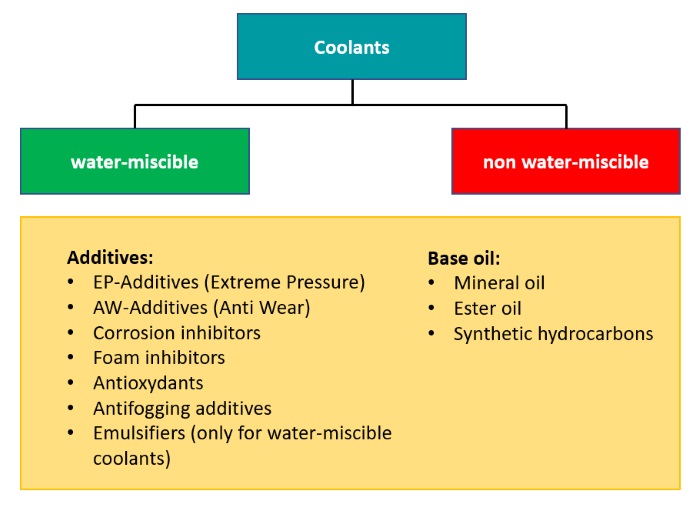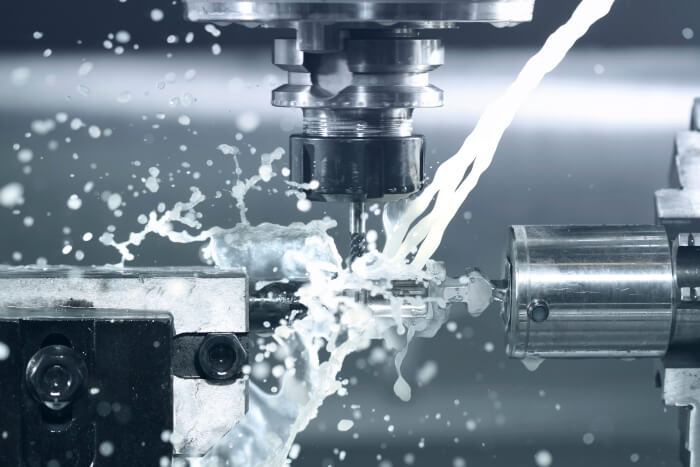


Coolants - ADDINOL Metalworking oils
Coolants are essential for the chipping and chipless forming of ferrous and non-ferrous materials. They cool, lubricate, rinse and remove separated particles, chips and foreign matter. The result of the machining process is decisively influenced by the coolant used and its quality.
ADDINOL coolants have proven themselves a thousand times over for many years. Whether high-alloy steel, cast iron, non-ferrous metal or aluminum – ADDINOL has the optimally suitable product for every material and every process.
Your benefits at a glance:
- wide selection of water-miscible and non water-miscible coolants
- efficient, safe operation
- long lifetimes
- best corrosion protection
- good skin compatibility
- optimal dimensional accuracy and surface quality of the workpieces
- maximum profitability
- excellent, personal service thanks to our Application Technology
Information about coolants
Composition of coolants
Coolants consist of base oils (mineral, synthetic or vegetable oils), water (in water-mixed coolants) and additives. The coolants basically differ in water-miscible coolants and non-water-miscible coolants.

The differentiation and definition of the individual types of coolants are regulated in DIN 51385. The document includes lubricants used for lubricating or for cooling and lubricating during machining and forming of materials, in particular metals. This DIN is for naming purposes only. A comparability of the coolants by tests is not given.
Water-miscible coolants vs. non-water-miscible coolants
Water miscible coolants are delivered as concentrate. Here the customer must mix the concentrate with a specified proportion of water to obtain the usable end product.
Non-water miscible coolants consist mostly of mineral oils or, in rare cases, synthetic oils. Depending on requirements, additives (e.g. based on phosphorus, sulphur or chlorine) are added to the oil. Non-water miscible coolants are ready mixed and can be used directly by the customer.
| Type | Advantages | Drawbacks | Purposes |
| Water miscible (wm) coolants |
|
|
|
| Non-water miscible (nw) coolants |
|
|
|
Additives in coolants
The most important additives for coolants are:
- EP additives (pressure resistance)
- AW additives (wear protection)
- Anti-corrosion additives
- Foam inhibitors
- Anti-fog additives (reduction of aerosols)
- Antioxidants (antioxidants)
- Dispersants (keeping small particles in suspension)
- Emulsifiers (ensure mixing of water and oil)
- Preservatives (biocides)
Requirements for coolants
Coolants must have a large number of properties in order to be used sensibly in practice:
- Cooling
- Greasing
- Sinks
- Corrosion protection
- Skin tolerability
- Ageing stability
- Resistance to bacteria and fungi
- Emulsifiability (water miscible coolants)
- Good foaming behaviour
- Dirt separation capacity
- Compatibility with metals, lacquers, elastomers
- Flame retardancy
- Low odour nuisance
- Long service life
To ensure that the coolants remain functional for as long as possible, it is necessary to clean the coolant. This is done via filters that remove foreign substances from the coolant and thus keep it clean. Solid foreign matter can also be removed with magnets or sedimented in a sedimentation tank. The introduction of foreign oil due to leaking lubrication systems on the machines is also undesirable. This can limit the properties of the coolant. If foreign oils are detected in water-miscible coolants, they can be separated using skimmers or extraction systems.
Applications of coolants
Coolants are typically used in metalworking for cutting (sawing, drilling, grinding) and non-cutting processes (bending, folding). The coolant serves to dissipate heat and prevents the working surface from overheating. This allows a workpiece to be machined longer, faster and more precisely. It reduces friction in the working process due to its lubricating properties. The tool is thus protected and can be used longer. It is also important to remove material such as chips or dust during production in order to keep the workplace clean. The corrosion protection properties of the coolant protect the tool, machine and workpiece from surface corrosion.

Selection of the coolant
Coolants are a high cost factor in metalworking. Experience has shown that they account for 8-16% of production costs. This means that they are roughly on a par with personnel costs. The tool costs are in comparison only 3-5%. You should therefore choose the best possible coolant to operate your system.
In order to select the right coolant for your plant, some questions must be clarified, in which environment the lubricant is to be used:
- Type of material (stainless steel, cast iron, aluminium, copper, etc.)
- Water type (hard, soft, deionised water)
- Regulations of the machine manufacturer
- Type of machine (single machine, machining method, machining centre, type of tool)
- Coolant system (single system, central system, filter)
- Coolant used so far (Were there problems such as corrosion, skin diseases or foam formation?)
- Special features of national legislation
Our application technology experts will be happy to advise you on your options.

Risk assessment for coolants
ADDINOL coolants are dermatologically compatible. In rare cases skin irritation can occur, however. To avoid this, please observe the following basic rules:
- Never wash your hands in the emulsion and do not use wiper cloths.
- Avoid use of compressed air for cleaning tools, workpieces and machines. Never use compressed air for cleaning your hands, because otherwise your skin will be injured.
- When working with compressed air please heed the respective protective measures and do not inhale vapours and aerosols produced.
- Keep the emulsion clean.
- Clean your hands before and after work. Do not use paste-type hand cleaners.
- Apply a fatty non-water-soluble skin protection cream before work and after breaks.
- Treat your hands to an application of conditioning cream after work and in your spare time.
Problems with coolants
If coolants are used in the wrong concentration or for the wrong field of application, various problems can occur in the production process. We have summarized the most common issues and have also listed causes, impacts and countermeasures.
| Challenge | Cause | Impact | Countermeasures |
| Bacterial infection |
|
|
|
| Fungal infection |
|
|
|
| Foam |
|
|
|
| Instability |
|
|
|
| Odours |
|
|
|
| Skin irritation |
|
|
|
| Corrosion |
|
|
|
Important note:
The risk of bacterial or fungal attack is very high with water-miscible coolants. Therefore, when using the device, ensure that it is properly cared for and maintained (documentation). If in doubt, replace the coolant instead of reusing it. Health risks should not be underestimated.
Replacement of the coolant
If the coolant is too dirty and works no longer as intended, it should be completely replaced. The condition of the coolant must be evaluated regularly using certain parameters. These include concentration, pH value, number of microorganisms, nitrite and nitrate content. If these values exceed prescribed limits, countermeasures are necessary. Signs for replacement may include: foul odour, clogging or corrosion. The replacement of the coolant is supported by the addition of a system cleaner which dissolves dirt, bacteria and fungi. Once the circulation system has been completely cleaned and disinfected, the old emulsion is drained. After a further rinse, the fresh coolant is added to the working process. The care of the coolant is worthwhile in any case. They extend the service life of the coolant, reduce the amount of waste, improve the quality of work, protect your workers and thus reduce costs in the long term.

Disposal of used metalworking fluids
The disposal of used metalworking fluids is regulated by law. In Germany, the “Waste Oil Ordinance” and for emulsions the “Closed Loop Recycling Management and Waste Management Act” with their respective provisions have to be observed. In other countries the respective national regulations are valid. In Europe “European Waste Catalogue Numbers” (EWC) are issued for all individual kinds of waste; they are declared on the Material Safety Data Sheets of all ADDINOL products. Used metalworking oils and emulsions are taken care of by officially accredited, licensed – and specially supervised – waste management enterprises and disposed of in accordance with the rules.
Metalworking oils which were not mixed with water can usually be treated like used oil when disposing or recycling. However, emulsions of water miscible coolants have to be treated differently. They can be subjected to processing before their recycling or disposal, during which the water and oil phases are separated. Avoid unnecessary pollution of the environment and reduce your disposal costs! Reduce the quantities of used coolants to a minimum. Extend the sump life of your emulsion by means of regular checks, care and maintenance in so far as it is reasonable taking into consideration the costs as well as job safety and hygiene. For larger companies an in-house coolant splitting plant can be meaningful: it can be viable for quantities of 30 t or more of waste emulsions per year.

Are you interested in our coolants? Find a sales partner near you.